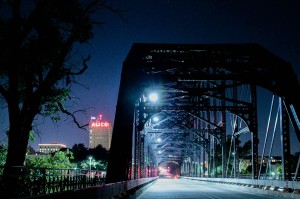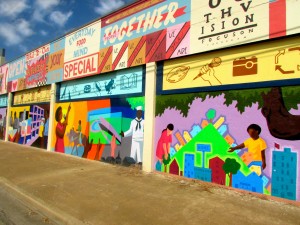Story and Photos by: Jordan Corona
On a brisk November morning, the Brazos rolls away, pensive with stories from a hundred years ago, ducks quacking along with it. It’s a murky flow, ebbing glinted bits of yellow Texas sunrise at its Waco banks. The river runs against this flat turf, northwest to southeast, at a mighty-Brazos diagonal.
For years, people living at the southwest bank watched the sun rise by the east. They said good morning to their neighbor and began a day’s work. Later, right about suppertime, those at the east bank bid their Brazos valley neighbors goodnight.
Say good morning to your neighbor.
Lula Jane’s Bakery has an honor-system coffee bar by the checkout counter. Nancy Grayson started the bakery on Elm Avenue. Atop a counter, adjacent to the checkout, there’s a coffee pot, some sweetener, an assortment of repurposed mason jars and unmatched coffee cups, and a jar for your honesty.
Just after cutting the grass behind the bakery’s garden, Grayson took a bite from her chocolate chip cookie and said, “I think integrity is extraordinarily important. Inherently, people want to be good.” For 50 cents, you may pour a cup of “cheap coffee,” and not have to feel out of place at the bakery if you can’t afford much else. Lula Jane’s is a new establishment in the community. She said the idea was to give people a meeting place, a reason to come to east Waco, sit down and talk and have some good food. It’s prophetic behavior in this neighborhood. The community’s best life was, is and will be when it’s positively engaged with it neighbors.
Say good morning to your neighbor.
“I think east Waco is vibrant but forgotten,” Grayson said.
Historically, the east Waco community had trouble proving its essentialness to the “other side of the river,” when the city expanded into a mid-century era of modernity. Waco’s growing pangs happened in sync with small municipalities all across the county. The 1950’s were tough on most urban centers as people became interested in moving away from the city after the Second World War. The federal government subsidized development projects, namely home building. Automobiles were much more popular than decades before so suburbia not only seemed desirable, but much more doable for some.
Racial integration, which was not popular in the southern part of the country, stimulated these sorts of migrations, meaning a more stratified municipality. The white population concentrated in the suburbs while the African American population moved from the outlying rural parts of their cities, into downtown districts, like east Waco. The Census Bureau reported the percentage of African Americans living in cities rose to 42 percent in 1950.
Dr. Van Allen was the vice president at Paul Quinn College, a school established by the African Methodist-Episcopal Church for African-American students. What started as a trade school in 1872 developed into a liberal arts college in the predominately African-American community of East Waco. And while the country wrestled with its race issues, leaders in civil rights mobilized from behind their pulpits and desks, gathered their congregants and walked their community to a new society.
The Rev. Ronald Gilbert, who pastored Carver Park Baptist Church, couldn’t march. Although he sat in a wheelchair he stood for the defenseless. He and his friends gave the community a progressive identity—a sense of purpose and belonging. “People looked to Reverend Gilbert for direction,” Allen said. “He had the trust of the people; they believed in his leadership.”
Times were uncertain and even violent at times, but the community’s leaders showed the city a new day, a second chance at life together.
They said good morning, neighbor.
Things in East Waco grew darker in the years after 1989, when Paul Quinn closed its doors for the last time and moved to Dallas. Three years later, Gilbert died. The community maintained its status as a city center for at least two decades after suburbanization. But the expansion ultimately strained the downtown economies on both sides of the river. At the end of the day, many business owners had to tack boards across their windows. “The parents told the young folks (students) to get an education ‘so you can get out of here,’” Allen said. “And the education they received didn’t teach them what they needed to straighten the system up. The kids never came back,” he said solemnly.
The departure of Paul Quinn College characterized the last of a long exodus of income and people from East Waco. The community had sprung a leak. While too many people moved away, too quickly, the buildings became dilapidated, and the place donned a stereotype for criminal activity. “Waco was a challenging environment when Paul Quinn left,” said Allen. “It left a void in the Waco experience.”
Allen still lives in a pretty, red, brick house with long white columns reaching up to the roof. Across the street from his home lies what remains of the old Paul Quinn campus.
Sometimes while he’s tending his front lawn, children will pass by on their way to school. “The kids will ask, ‘Hey mister, do you live there?’” he said. “I wave at them and say, ‘I sure do.’” Allen wants to be a positive role model in his community. He wants to give back. So he’s staying.
It’s been years since Jeanette Bell has mothered children in her home on Spring Street, just off Elm Avenue, behind the East Waco library. In fact, her children now have children of their own. Once, she would lean over the sleeping, warm bodies, hug and kiss them good morning for it was time for school. “We’d pray and thank God for letting us see another day,” she said. “And ask him for help making good decisions.”
Bell remains grateful for a new day. As her community in East Waco begins to shake off a few decades of social and economic disparity, Bell’s taken a leadership role in her neighborhood to see a change. Bell serves as president for her neighborhood association in East Waco and sits on the Waco Downtown Development Corp. board. “I’ve really been trying to promote housing, economic, community and business development over here,” she said.
Bell, who’s lived in Waco for more than 20 years, said she couldn’t help but feel there has been a general lack of investment in her community for years. “This area was once thriving, surviving and providing,” she said. “Now there are no jobs.”
Far from a cry for pity, Bell respects the power of the people in her community and said things are changing for the better. But it’ll take some intentional thought and creativity to restore what over 60 years of economic decline did to the community.
It’s a new day for Waco.
The East Waco community, particularly, is waking to a new era of socially responsible development and progress. Considering the nature of the community’s specific difficulties, “socially responsible” seems to be the key ingredient when it comes to development. It’s not enough to bring new things—East Waco’s got streets full of concrete things, boarded-up things, broken things. People in East Waco are talking. East Waco wants to not be forgotten, but to make a lasting legacy with the rest of the city.
Marissa Binkoski and Emily Heit are interns at the World Hunger Relief Farm. Every week, they drive to J.H.Hines Elementary to teach an after-school garden club. “It’s always terror and then fascination,” Heit said. The two laughed thinking about the first time they showed the children a live turkey. She and Binkoski are introducing some very non-urban ideas to the students’ understanding.
“It’s important to know where your food comes from,” said Binkoski. “As I see it, food is foundational. And you don’t have to be super talented to grow your own food.” Heit convinced the children she spends time with are Waco’s future.
She said making the natural world relatable to children who live in a community scarred by urban culture will equip those children to contribute better things to the community.
“When a community is part of a garden, they’re participating in a real life and death processes,” Binkoski said.
Engaged community development means good things for East Waco. Economic growth can work wonders for a community in disrepair. But the brokenness and the decay were never as much about the missing dollars as it was about being forgotten and being left behind.
East Waco is strong and vibrant, but that’s nothing new. It’s a community of hard-working people. Many of them stayed with their neighbors and friends, committed, even after things got tough.
New life to an old downtown district will feel something like soul. But the true life of a community comes with the dawn.Watch the sunrise in the east and say, “Good morning, neighbor.”



